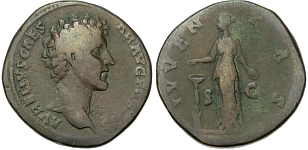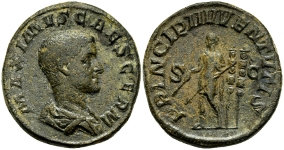Fine Coins Showcase
Antiquities Showcase
Show Empty Categories
Shop Search
Shopping Cart
My FORVM
Contact Us
About Forum
Shopping at Forum
Our Guarantee
Payment Options
Shipping Options & Fees
Privacy & Security
Forum Staff
Selling Your Coins
Identifying Your Coin
FAQs
zoom.asp
Home ▸ Catalog ▸ |Themes & Provenance| ▸ |Personifications| ▸ |Youth||View Options:   | | | | | | Juventas is Roman goddess of youth and before she married Heracles was the cupbearer for the gods and goddesses of Mount Olympus, serving nectar and ambrosia. Boy's offered Juventas a coin when they put on the adult men's toga for the first time. |


Following tradition, when young Nero was elevated to princeps juventutis (prince of youth) in 51 A.D., the equestrian order (Roman knights) gave him a silver buckler (a small round shield) and lances. Coins depicting these traditional gifts were issued for Caius and Lucius, when they were designated princeps juventutis in the time of Augustus. Aurei and denarii with the same types were struck for Nero at Rome. Due to the rarity of the type and the lack of S C on the reverse, it was long believed this type was funded by the knights for distribution as gifts to attendees at the event where Nero was given his buckler and lances. In SNR 63 (1984), von Kaenel re-attributed this type to a Thracian mint. A few dozen examples are know and some, according to RPC I, were found in Thrace.RB88176. Orichalcum sestertius, von Kaenel Thrakien, type A (unlisted dies); RIC I Claudius 108 (R4); BMCRE p. 195 note, pl. 37, 4; BnF II Claudius 288; Cohen I 99; see RPC I p. 311, aVF, dark brown near black patina, minor roughness, weight 26.001 g, maximum diameter 33.8 mm, die axis 180o, uncertain Balkan or Thracian mint, as caesar, 51 - 54 A.D.; obverse NERONI CLAVDIO DRVSO GERMANICO COS DESIG, bare headed and draped bust right; reverse EQVESTER / OR-DO / PRINCIPI / IVVENT in four lines on a buckler (small round shield), lance vertical behind; ex CNG e-sale 424 (11 Jul 2018), lot 434; ex CNG e-sale 174 (10 Oct 2007), lot 204; ex CNG auction 67 (22 Sep 2004), lot 1316; ex Michael Weller Collection; very rare; SOLD
Diadumenian, Mid May - 8 June 218 A.D.


In 217, the Colosseum was badly damaged by a fire started by lightning, which destroyed the wooden upper levels of the amphitheater.SH99215. Silver denarius, RSC III 3, RIC IV 102.2a (S), SRCV II 7449, BMCRE V 88 (seen from the front), Hunter III 2 var. (same, also cuirassed), Choice VF, well centered, excellent portrait, toned, flow lines, small green encrustations, tiny edge splits, weight 3.148 g, maximum diameter 20.0 mm, die axis 0o, Rome mint, as caesar, May 217 - mid May 218 A.D.; obverse M OPEL ANT DIADVMENIAN CAES, bare-headed and draped right, seen from the front; reverse PRINC IVVENTVTIS (Prince of Youth), Diadumenian standing facing, bare head right, wearing military garb, standard in right hand, short scepter in left hand, two grounded standards to right, one to left; ex KŁnker auction 318 (11 Mar 2019), lot 1461; scarce; SOLD
Diadumenian, Mid May - 8 June 218 A.D.


Diadumenian was so named because he was born with a caul that formed a 'diadem.' A caul is a piece of membrane that can cover a newborn's head and face. Birth with a caul is rare, occurring in fewer than 1 in 80,000 births. The caul is harmless and is immediately removed by the physician or midwife upon delivery of the child.SH82698. Silver denarius, RSC III 12; RIC IV M107.1a (S), Hunter III 1, cf. BMCRE V p. 508, M82 (antoninianus, but denarius noted); SRCV II -, Choice gVF, excellent reverse, full circles strike, obverse die wear/rust, tiny edge cracks, weight 2.447 g, maximum diameter 19.9 mm, die axis 0o, Rome mint, as caesar, 1st emission, c. May - 31 Jan 217; obverse M OPEL DIADVMENIANVS CAES, bare-headed and draped bust right, seen from behind; reverse PRINC IVVENTVTIS (Prince of Youth), Diadumenian standing slightly left, head left, in military dress, baton in right hand, scepter nearly vertical in left hand, legionary aquila and standard topped with a wreath on right standing in ground behind him; scarce; SOLD
Maximus, Caesar, 235 or 236 - 24 June 238 A.D.


When Augustus ruled Rome, he was not called emperor or king, he was the Princeps, the "first of men." In the empire, the designated successors to the emperor were named caesar and also given the title Princeps Juventutis, the "first of youths." This is the origin of the English word prince, meaning the son of a monarch.SH89839. Orichalcum sestertius, RIC IV 13, BMCRE V 213, Hunter III 11, Cohen IV 14, SRCV III 8411, gF, excellent portrait, well centered, edge split, weight 23.265 g, maximum diameter 32.3 mm, die axis 0o, Rome mint, early 236 - Apr 238 A.D.; obverse MAXIMVS CAES GERM, bare-headed and draped bust right, seen from behind; reverse PRINCIPI IVVENTVTIS (to the Prince of Youth), Maximus standing left, head bare, short scepter in right hand, transverse spear in left hand, two military standards behind, S - C (senatus consulto) flanking across field; ex Numismatik Naumann auction 73 (6 Jan 2019), lot 543; scarce; SOLD
Diadumenian, Mid May - 8 June 218 A.D.


Diadumenian was so named because he was born with a caul that formed a 'diadem.' A caul is a piece of membrane that can cover a newborn's head and face. Birth with a caul is rare, occurring in fewer than 1 in 80,000 births. The caul is harmless and is immediately removed by the physician or midwife upon delivery of the child.SH34941. Silver denarius, RIC IV 107.1a (S), RSC III 12; Hunter III 1, cf. BMCRE V p. 508, M82 (antoninianus, but denarius noted); SRCV II -, aEF, weight 3.325 g, maximum diameter 19.8 mm, die axis 0o, Rome mint, as caesar, May 217 - mid May 218 A.D.; obverse M OPEL DIADVMENIANVS CAES, bare-headed and draped bust right, seen from behind; reverse PRINC IVVENTVTIS (Prince of Youth), Diadumenian standing slightly left, head left, in military dress, baton in right hand, scepter nearly vertical in left hand, legionary aquila and standard standing in ground behind him on right; scarce; SOLD
Marcus Aurelius, 7 March 161 - 17 March 180 A.D.


Juventas is Roman goddess of youth and before she married Herakles was the cupbearer for the gods and goddesses of Mount Olympus, serving nectar and ambrosia. Boy's offered Juventas a coin when they put on the adult men's toga for the first time. RB32849. Copper as, RIC III AP1238a, BMCRE IV AP1407, Cohen III 393, Hunter II 39, SGCV II 4831, VF, weight 10.947 g, maximum diameter 25.2 mm, die axis 0o, Rome mint, as caesar, 143 A.D.; obverse AVRELIVS CAESAR PII F COS, bare head right; reverse IVVENTAS, Juventas standing left, offering incense with right at altar-candelabrum on left, patera in left, S - C (senatus consulto) flanking thighs; very scarce; SOLD
Philip II, July or August 247 - Late 249 A.D.


In 145, many thousands of acres of Roman Britain, in modern-day Lincolnshire, England, were inundated by a great flood.RB76161. Orichalcum sestertius, RIC IV 256a (S), Cohen V 49, Hunter III 14, SRCV III 9249, Choice VF, excellent boy portrait, well centered, nice patina, a few marks, slightest corrosion in some areas, weight 20.220 g, maximum diameter 30.0 mm, die axis 0o, Rome mint, as caesar, 244 - 246 A.D.; obverse M IVL PHILIPPVS CAES, bare-headed, draped, and cuirassed bust right, seen from behind; reverse PRINCIPIA IVVENTVTIS (in honor of the Prince of Youth), Philip II standing left, bare-headed, in military dress, globe in right hand, inverted spear behind in left, S - C (senatus consulto) flanking across field below center; scarce; SOLD
Marcus Aurelius, 7 March 161 - 17 March 180 A.D.


Juventas is Roman goddess of youth and before she married Herakles was the cupbearer for the gods and goddesses of Mount Olympus, serving nectar and ambrosia. Boy's offered Juventas a coin when they put on the adult men's toga for the first time. RB51525. Orichalcum sestertius, RIC III p. 173, 1232a (S); BMCRE IV p. 225, 1397; Cohen III 392, Hunter II 38 var. (slight drapery), SRCV II 4804 var. (draped), gF, weight 27.727 g, maximum diameter 32.4 mm, die axis 0o, Rome mint, as caesar, 140 - 144 A.D.; obverse AVRELIVS CAESAR AVG PII F COS, bare head right; reverse IVVENTAS (youth), Juventas standing slightly left, head left, draped, dropping incense with left hand onto altar on left, patera in right hand, S - C (senatus consulto) across field; scarce; SOLD
Maximus, Caesar, 235 or 236 - 24 June 238 A.D.


When Augustus ruled Rome, he was not called emperor or king, he was the Princeps, the "first of men." In the empire, the designated successors to the emperor were named caesar and also given the title Princeps Juventutis, the "first of youths." This is the origin of the English word prince, meaning the son of a monarch.RB84929. Orichalcum sestertius, RIC IV 13, BMCRE V 213, Hunter III 11, Cohen IV 14, SRCV III 8411, aVF, perfect centering, nice portrait, porous, weight 21.246 g, maximum diameter 31.0 mm, die axis 0o, Rome mint, early 236 - Apr 238 A.D.; obverse MAXIMVS CAES GERM, bare-headed and draped bust right, seen from behind; reverse PRINCIPI IVVENTVTIS (to the Prince of Youth), Maximus standing left, head bare, short scepter in right hand, transverse spear in left hand, two military standards behind, S - C (senatus consulto) flanking across field; scarce; SOLD
Hostilian, Summer - November 251 A.D.


When Augustus ruled Rome, he was not called emperor or king, he was the Princeps, the "first of men." In the empire, the designated successors to the emperor were named caesar and also given the title Princeps Juventutis, the "first of youths." This is the origin of the English word prince, meaning the son of a monarch.RS93311. Silver antoninianus, RIC IV 181d (S), RSC IV 34, Hunter III 4, SRCV III 9561, VF, toned, some luster, flow lines, die wear, light marks, dark spots, weight 3.944 g, maximum diameter 23.0 mm, die axis 0o, Rome mint, as caesar, late 250 - early 251 A.D.; obverse C VALENS HOSTIL MES QVINTVS N C, radiate and draped bust right; reverse PRINCIPI IVVENTVTIS (to the Prince of Youth), Hostilian standing half left, standard in right, reversed spear in left; from the Errett Bishop Collection; scarce; SOLD

You are viewing a SOLD items page.
Click here to return to the page with AVAILABLE items.
The sale price for a sold item is the private information of the buyer and will not be provided.



Page created in 1.218 seconds.






